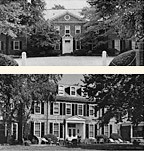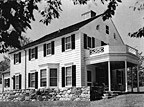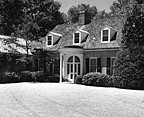Mott Schmidt Biography
- Featured Architecture:
- ABOUT MOTT SCHMIDT
- Introduction
- Beginnings and Sutton Place
- Townhouses and Apartments
- Country Houses
- Late Works
- Townhouses
- Sutton Place
- Anne Morgan Townhouse
- Mrs W.K. Vanderbilt Townhouse
- Guy Fairfax Cary Townhouse
- Miss Emily Trevor Townhouse
- Vincent Astor Townhouse
- Walter E. Hope Townhouse
- Apartment Houses
- 53 East 66th Street
- 1088 Park Avenue
- 19 East 72nd Street
- Country Houses
- Mr & Mrs Clarence Dillon Summer House
- Pook's Hill: Mr & Mrs Mott B. Schmidt Country House
- Marienruh: Mrs Serge Obolensky Country House
- Mr & Mrs Bernard Peyton Country House
- C. Douglas Dillon Country House
- Hudson Pines: Mrs David M. Milton Abby Rockefeller Country House
- Hillcrest: Mrs Martha Baird Rockefeller Country House
- Municipal Buildings
- Municipal Building and Post Office, Mount Kisco
- Susan B. Wagner Wing, Gracie Mansion
- Other Buildings
- French City Village Houses
- Selected Commissions for the Rockefeller Family
by Mark Alan Hewitt
- Maintaining the Tradition
- New Clients
- Gracie Mansion
- The Susan B. Wagner Wing
- Retirement and Retrospective
- A Quiet Legacy
Schmidt became financially strained in the late 1940s and was forced to sell Pook's Hill in 1950, moving into a smaller house in Katonah, New York, also of his own design. Tragedy struck in 1954 when his only child, Elena Chandler, died at the age of thirty as a result of childbearing complications. The next year his wife, Elena, died of cancer, and his output slowed for the remainder of the decade. Yet, after a difficult period during the early fifties in which commissions were few, Schmidt's practice experienced a resurgence. A September 1957 article in the New York Times noted his accomplishment as a builder of estates in "the Grand Manner":
Mott B. Schmidt, who has designed town and country houses for Rockefellers, Morgans, Vanderbilts and Astors, says that during the last few years he has drawn and executed more plans for country homes than at any time since 1921, when he began to specialize in this field of architecture. The plans spread across the drawing boards in his office at 14 East Forty-sixth Street, and the daily round of visitors to his pine-paneled consulting room, furnished with antique French and Italian pieces, confirms the revival of interest in luxurious country living.
This new group of well-to-do clients recognized
Schmidt as an architect with the experience and taste to handle traditional
houses. As the architect said, "When a person can build without budget
worries, he can blend the practical with the esthetic in any way that satisfies
him." Thus, in a time governed by frugal, modernistic taste, Schmidt was
able to design a series of relatively large houses, costing $250,000 or more,
which extended his experiments in the country house to the suburban type.
Houses epitomizing luxurious country living were built for Mr. and Mrs. Ralph
C. Price, of Greensboro, North Carolina (1953); Mr. and Mrs. Edgar Bronfman,
Jr., of Seagram fame, in Purchase, New York (1955) (Figure 42); the president
of Chase Manhattan bank, John McCloy, in Stamford (1956) (Figure 43); and
William Clay Ford of Grosse Pointe, Michigan (1959) (Figure 44). As a rule
Schmidt relied upon models already developed during the 1930s for these works.
Both the Price and Bronfman houses were compact refinements of the 5-part
formula and are probably the most successful of the 1950s estates. They had
large garages, complex mechanical systems, and a surplus of bathrooms - signs
of their gadget-oriented times.
Schmidt may well have been more comfortable with compact and restricted
programs. Indeed, some of his best late work was done with rather small houses.
His 1957 house in Bedford Hills, New York, for newspaperman and historian
Donald Marshall and his wife is carefully massed and detailed and fits its
wooded site beautifully (Figure 45). A similar design was made for Murray D.
Safanie nearby in Katonah (1958). A larger but still trim colonial saltbox
house in Connecticut for oilman John M. Lovejoy (1949) was also well sited and
proportioned, if very modest in its articulation. This fertile period
culminated when Schmidt remarried in 1958. He and Katharine Temple Lapsley had
known each other when she was a girl in her hometown of Bedford, New York.
After working with the Office of Strategic Services in Washington and the Voice
of America in New York, and having an ended marriage to Melville Stone, she returned
to Bedford in 1957, where she and Mott Schmidt were reacquainted. With his
second wife he found renewed energy, support for his work, and happiness. He
might easily have retired had it not been for one final challenge.



